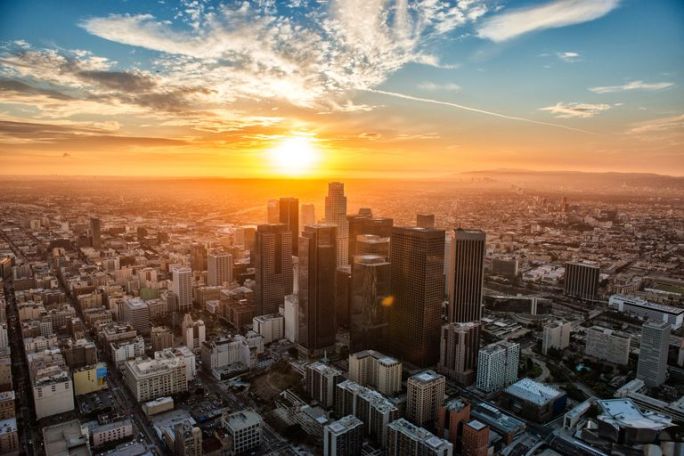
For this blog I would like to discuss and present a case for the need for the heat island effect to be addressed. So firstly how exactly does the #urbanheatislandeffect (UHI) work and why should we even consider being concerned? Watch this video below to get an idea of the UHI, with the example of Western Sydney:
So this concept has actually been around for a while now but I believe that considering how much we know and have researched and studied into this field it is surprising the lack of actual change has occurred. So for this blog I will:
- Discuss the implications of UHI effect for the future
- Present the strategies we have now to address it and what are the benefits
- Consider what barriers need to be overcome to address the issue
- Use the principles of #ecologicalengineering to suggest a way forward
Implications of the UHI effect
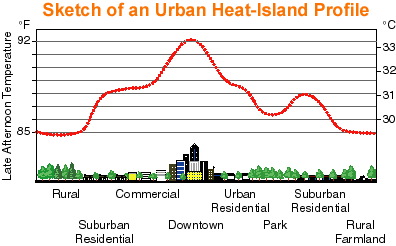
“If you can’t stand the heat, get out of the kitchen.”
Harry S. Truman
The only problem of course with this quote is the implication that if we can’t handle the pressure we should leave it for someone else; a classic way to neglect future generations, an attitude that I think we need to squeeze out of society.
A recent study (only one of many examples) in Hong Kong showed that the city had a rise in urban mean temperature of 0.169 degrees centigrade per decade for the last four decades. Even here in Australia it has been found by the Melbourne City Council that the average temperatures within the CBD are up to 4 degrees higher than surrounding suburbs.
This phenomenon can be clearly seen as an issue when combined with one of the worlds deadliest natural disasters, in fact this disaster can be held responsible for up to 70, 000 deaths in Europe during the 2003 episode. This natural disaster is known as a #heatwave.
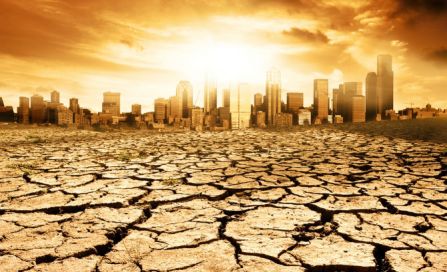
The pre-existing UHI effect means that cities are more vulnerable to heat waves than surrounding rural areas. Why is this exactly?
So the UHI effect is a localised phenomenon, it creates a permanent temperature anomaly, spatially concentrated. Read this excellent study which looks into the physics details about how this effect works. Whereas heat waves are more large scale, temporal high pressure systems producing an anomaly increasing the air temperature for rural and urban regions. We do have some idea of how the interactions between these effects can lead to intensified heat. Also read section two of this paper to get a better idea of how urban environments impact the balance of energy.
Breaking the problem down further there are two main reasons I believe are sufficient enough to catalyse a movement to deal with the increased heat in urban areas. These refer to our base case, the “business as usual” scenario:
- We know that 50% of the worlds population lives in cities and this is widely known to be increasing, by 2050 it is expected that 66% of the worlds population will be living in cities
- We also know that climate change will result in an increase in frequency and severity of heat wave events
- We know that heat waves cause more deaths than floods, hurricanes and tornadoes combined.
The image below highlights the changes that we have already been able to quantify in Australia. In Melbourne, 2013 there was approximately 200 heat related deaths and the predictions are for this to double by 2030. It is a well known fact that, even in Australia, the more vulnerable (the elderly, people with pre-existing medical conditions and the poor) suffer the most from extreme weather conditions. Globally this is also the case, often poorer countries are located in the tropics and Nicolas Herold, a fellow at the Climate Change Research Centre at the University of New South Wales said that he and his fellow researches found that the increase in extreme heat measurements has been more pronounced in poorer countries:
“We expected it to be a lot worse since the [low-income] countries are near the equator but the difference of more than double is quite shocking”.
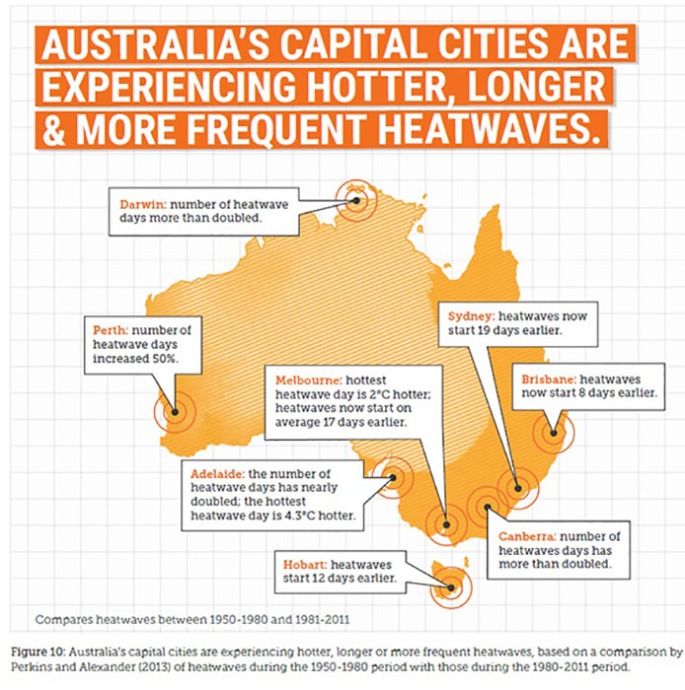
There are other consequences of increasing UHI effect combined with heat waves, I found highlighted nicely in an article I read, that I also think should be considered:
- The increase in energy consumption and chemicals released by cooling equipment
- In some places, the increase in power outages
- Higher concentrations of air pollutants
- Promotes the creation of ground level ozone which has been known to lead to health issues and intensify numerous breathing problems
- Higher temperatures of storm water (due to the heating of urban surfaces) which reduces the amount of dissolved oxygen in the water of nearby bodies
What we can do and the benefits
There has been extensive research into methods of combating the UHI effect in order to reduce the severity of the impact of heat wave events on the urban environment. I would like to break them down into 3 areas, one of which I will discuss. The second is to change the colour scheme of our built environments, as is being done in Western Sydney (image below, read here for more on this project and here and here for more on decreasing albedo). The third is the modification, planning and the design of cities to increase air flow, an interesting case I found of this is in Stuttgart in Germany, which you can read about here.
 Western Sydney’s project for paler roads, watch the video on their website for more.
Western Sydney’s project for paler roads, watch the video on their website for more.
#Greenspaces
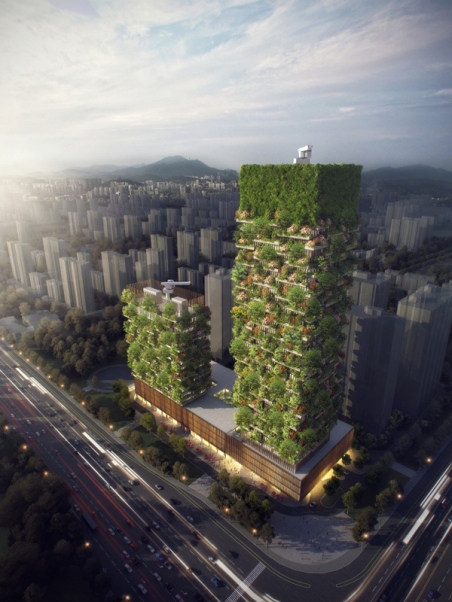
I read an exciting study published this year, the results of which suggests that:
“…tree dominated greenspace offers the greatest heat stress release when it is most needed.”
A study (discussed in the previously mentioned article) conducted of Glasgow predicted that an increase of 20% in greenspace could eliminated between a third and a half of the cities expected UHI effect in 2050!
In many European cities there has been a push towards rooftop gardens. There are also other creative solutions such as greenscaping into vertical gardens such as in the image to the left, in places such as Bangalore and Beijing.
Just having a surface covered shade can reduce its surface temperature by 11-25 degrees but I think that the most impressive part about greenspaces as a mitigation technique for UHI is the broad range of benefits associated:
- Other ecosystem services – reduced surface runoff and modification of micro climates
- Increased biodiversity
- Aesthetically pleasing
- Reduction in energy costs (shading from trees means nearby buildings require less cooling)
- Improve air quality
- Storm water management and improve water quality
- Can reduce noise
- Decrease stress on water resources
It is quite exciting to think about all of the positives to come out of one relatively small change, which I think will also improve the #livability of our cities, something that seems to be particularly a cultural movement in Australia, to aim for enhanced “livability”.
Who is involved
This is a business case though so I must also address stakeholders and the economic side, as I have clearly highlighted many environmental and indeed ecological benefits. The wider community clearly has much to benefit from a solution like this, not only does it make our neighbourhoods more aesthetically pleasing but also as I have mentioned earlier the health benefits are measurable when it comes time for heat waves. The reduction in energy consumption within buildings introduces big company owners or government agencies who are spending the money to keep their buildings cool. On a wider scale I think it is also important to include future generations as stakeholders as by following “business as usual” current generations are leaving the more severe consequences to be dealt with in the future. I think that local, state and federal government also have parts to play with different levels of the problem. On a grander scale the Federal government have an environmental responsibility (also a global responsibility) and on a local scale the other benefits such as the reduction in noise, for example, are the kind of issues that should be considered anyway.
Arguably it is a good option economically as well. A 5-city study conducted in the US found that when quantified, the benefits of the planting the extra trees amounted to $1.50-$3 per dollar invested!
Something from me
I believe that the way forward isn’t necessarily only to use these methods, I think we are still at the stage where we can consider alternatives that may also assist in mitigating the UHI effect, though clearly greenspacing is such an elegant solution. To come up with these alternative solutions, we should be considering the design principles for ecological engineering (please see my first blog post to be more familiar with these).
I would like to point out the the second principles, design for site specific context, this I think highlights the limitations with the use of greenspaces. In Australia water is more of a limiting resource in comparison to Europe, where vertical forests have the ability to flourish, though a city like Perth does have a lot more open space to be able to have standard greenspaces.
There are studies that have shown that the effectiveness of greenspaces is “…subjective to effective geometry and width…”. This limitation of required area could cause a problem for cities that are quite dense, and ironically some of those cities have a greater need for these systems.
I combined my knowledge of the principles of ecological engineering, and thought why aren’t we utilising what we already know about the natural world? After all the reason we are having this issue in the first place is because the design of our cities inadvertently alters the natural order. The way I see it is that the UHI effect isn’t just a result of many anthropogenic mishaps but also a representation of our lack of ability to incorporate ourselves with the natural environment.
A survey of North American trees found that plants protect their ability to photosynthesise by maintaining a leaf temperature of about 21 degrees, no matter the external environment. Plants use several mechanisms to do this, such as changing the angle of their leaves relative to the sun. This made me question why our built environments aren’t also flexible to adapt to an environment that changes so rapidly over short periods of time? Why aren’t we creating design consistent with ecological principles, to mimic our natural environment (the second design principle).
And so I have chosen to pitch to you my suggestion in a Vlog, for possible ways we could mimic our natural environment to address UHI effect, please enjoy below:
The article about Fred and his kind.
Evaporation on its own can decrease peak summer temperatures by 1-5 degrees Celcius. The maintenance and initial planting costs associated with greenspaces were estimated in a study on 5 US cities and their urban forestry programs to be 15-65 US dollars a year per tree. Imagine if we could come up with an idea like this one, a once off alteration to manufacturing and building our cities that could assist in decreasing the UHI effect. As soon as I had the idea I realised the limitations and that it too would have to be considered for each site separately (second principle). But I think that where we are falling short is the first principle, solutions that mimic nature. What other cooling mechanisms in the natural world could we mimic? Post any ideas for this below, I would love to hear them. I think it is important for us to consider alternative solutions in order for us to make positive change seem more desirable, possibly in this case, financially.
Maybe there are many other applications for this, possibly in water transport, I would love to know what you all think? Will ideas such as this one fit into the design principles for ecological engineering? Please post ideas/limitations or other comments below.
References for images used in video:
- Awake 2015. The thorny devils moisture extracting abilities. Available from: <https://wol.jw.org/en/wol/d/r1/lp-e/102015365> [16 May 2017]
- Photopoulos, J, 2016. Desert lizard an sip water from sand through its feet and back. Available from: <https://www.newscientist.com/article/2111237-desert-lizard-can-sip-water-from-sand-through-its-feet-and-back/> [17 May 2017]

Great work Emily! You brought up an issue which is so critical for people in countries like ours (highly urban and in an hot environment!)
LikeLike
Thanks! I tried to cater it to Perth and Australia a little but there is room to do more in that direction I think, trying to be site specific isn’t as easy as you would expect sometimes!
LikeLike
Fred has some really smart skin, pretty cool that we can learn a lot from things you can’t even see. I wonder how much water could be collected from using materials that improve condensation?
LikeLike
I am sure if we digged a little further we could find some more information. I did find some research that had already looked into modifying the structure of the surface of concrete to change contact angle, I think it is just one more step to look into condensation
LikeLiked by 1 person
A really well-structured and interesting business case, Emily! Crazy how hydrophilic-Fred can move water against gravity with no energy. It reminds me of how tall trees can effectively pump water up a multitude of stories with only capillary action. We can certainly learn a thing of two to possibly tackle UHI. Good job.
LikeLike
That’s the thinking I first started with, trees! Fred was just an abstract idea, trying to portray the point that we should be mimicking these impressive natural wonders 🙂
LikeLike
This was awesome to see a different perspective, as I also looked at the urban heat island effect! I love how you looked at the cooling system of a reptile for future urban planning. Makes sense!
LikeLike
I really think that the UHI effect is one of the biggest problems we’ll face in a future that is moving towards global warming and I’m so glad that you addressed it! With such an economical and environmentally inspired design, I think it should be so much easier to integrate such an amazing solution. Such a great blog Emily!
LikeLike
Ur blog let me recall the time I lived in paramatta-the western Sydney. Lots of land were used to develop residential and business property rather than green spaces, which I think contributed to the UHI effect, can’t believe I has lived in a place where its temperature is higher than other suburbs lol. I like ur thinking about intergeneration, which also can be considered a principle of ecological design. Additionally, I can obtain huge thoughts from these related journals given by u, cheers.
LikeLike
Awesome read! Super informative + I really liked how you used a wide range of sources and kept on putting your own touch on things!
Chris
LikeLike
This was so easy to read! Loved the use of colours… made me feel kind of warm just reading git haha. I think the problem of urban heat is something that really needs to be addressed. I feel it myself when I’m walking through the CBD in summer so its absolutely something noticeable. I think this blog will really help people to understand its importance and how it can be addressed moving forward! – Daniel 🙂
LikeLike
Thanks Daniel! I hope you are right and that maybe reading my blog will help with people’s understanding, that’s the first step I think
LikeLike
Really like this one Emily! Particularly the link to bio-mimicry (and Fred) who can teach us a lot!! I’m subscribed so look forward to reading potential future blog posts!
LikeLike
I am glad Fred is a winner, thanks Blake!
LikeLike